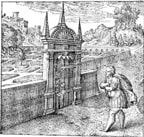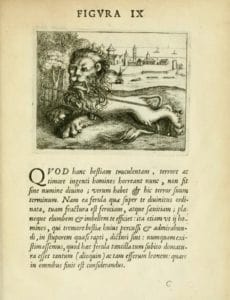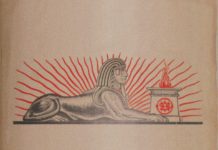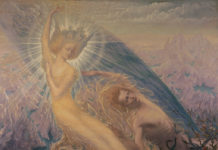When the Fama Fraternitatis first left the printing presses of Wilhelm Wessel in 1614, the resulting ‘furore’ ignited a flame right across the cultural mindset of Europe. Such was the extent of the controversy it later came to be labeled by the ill-fated historian Francis Yates as the ‘Rosicrucian Enlightenment’. The Fama famously heralded the arrival of a previously unknown philosophical secret society founded in medieval Germany by the fabled monk Christian Rosenkreutz. Its narrative is one of Rosenkreutz and his mystical sojournment to the East and with it the recovery of esoteric knowledge to the West; it triggered what can only be described as a literary sensation that eventually comes to permeate much of the intellectual landscape of the seventeenth-century.
The Fama Fraternitatis lays down the basic tenants of Rosicrucianism and presents a rather sketchy narrative of the Order’s legendary founding. The narrative explains that after Fra. C.R returned from the East and following an unceremonious rebuke by the European intelligentsia ‘he spent a great time in the mathematics and made many fine instruments’. After five such years of solitary study and the contemplation of fine working tools and instruments, Fra. Rosenkreuz sees fit to call on three more brethren to join him from his former cloister; Brother G.V., Brother J.A., and Brother J.O. It is thus that the foundations of the Fraternity of the Rosy Cross are laid.
If we look to the famous Rosicrucian engraving known as The Temple of the Rosy Cross by Theophilus Schweighardt Constantiens in his pseudonymous Speculum Sophicum Rhodostauroticum (1618), we can see depicted how these four founding members go on to complete the work of Rosenkreuz’s new building known as the Sancti spiritus, after which the Fama tells us the brethren concluded that their numbers should increase once more. It would seem there was plenty of volunteers, as the Spanish scholar Carlos Gilly has shown; we now know that between 1614 and 1620 more than two hundred zealous replies were published both for and against the movement in response to the Fama.
Following their admittance, these brethren are informed that the philosophy of the Order was ‘not a new invention’ but a form of prisca theologia – a pristine theology. The philosophy of the Rose Cross is the knowledge known to Adam, Moses and Solomon. It is the means by which we find reconciliation in philosophy and theology, of science and religion, of technology and faith – ‘All that same concurreth together, and makes a sphere or Globe, whose total parts are equidistant from the Centre’.
The Fama explains how the brethren are warned of those ‘accursed’ gold-makers who would use this ‘true philosophy’ for less noble or spiritual means. These ‘many runagates and people do use great villanies and cozen and abuse the credit which is given them’. Intent on stealing the master’s secret wisdom for less pious ends, such ruffians are as the Fama indicates, best avoided. Furthermore, it also suggests that a Brother seeking the true alchemy (a spiritual transmutation) should disregard or indeed mentally divest themselves of the want of precious metals.
As one might expect of such a characteristically and overtly prophetic document as the Fama, millenarian and eschatological tendencies colour much, if not all of its allegorical and symbolic imagery. There are, however, some very straight forward proto-masonic allusions:
He thought (he being a good architect) to alter something of his building and to make it more fit…and so, unlooked for, uncovered the door…For like as our door was after so many years wonderfully discovered, also there shall be opened a door to Europe (when the wall is removed) which already doth begin to appear, and with great desire is expected of many.
As we can see from the above passage, the secret wonders of the Fra. Christian Rosenkreuz, whose unerring learning in the arts was ‘like a globe or circle, to the only middle point and Centrum’, – were, in fact rediscovered by a ‘good architect’. We are informed that while in the course of his labour, this ‘good architect’ (Brother N.N.) uncovers a door to a fabulous hidden tomb – the tomb being that of Fra. C.R. It being a ‘greatly desired’ door, the Fama details how this ‘good architect’ removes ‘the wall’ and hence opens the door unto Europe.

The allegorical and symbolic nature of this ‘wall’ might well be discerned if we assess this ‘good architect’ in relation to that other virtuous character named in the Fama who ‘shall undoubtedly give to the world the last light… likewise hath Theophrastus been in vocation and callings’. This ‘Theophrastus’, who is undoubtedly the Swiss Theophrastus Bombastus von Hohenheim, known as Paracelsus (1493-1541), had an influence that not been fully set in motion until his death, and not until 1589-1591, 1603 and 1605 with the printing in Basel of the Johannes Huser of Waldkirch (Baden) editions of works like Opus paramirum and Philosophia Sagax, had the Paracelsian legacy permeated it’s fertile native Lutheran soil and found its way into the sacred repository of Frater C.R’s tomb. As the Fama states ‘Wherein there lays divers things, especially all our books, which otherwise we had. Besides the Vocabular of Theoph: Par. Ho.’
Such an acronym would not have been lost on Fama’s receptive audience. With the stability offered by the Peace of Augsburg in 1555, non-doctrinal aspects of speculative spiritual discourse were finding a particularly receptive audience in minds savaged by the Thirty Year War. Anti-orthodox movements represented by the likes of Sebastian Franck (1499-1542), Casper Schwenckfekd (1489-1561) and Valentin Weigel had propagated radical Paracelsian ideas of the Kirche ohne Mauer against the Steinkirche or Mauerkirche (church of stone or walled church) indicative of ever-intensifying Lutheran orthodoxy. Paracelsus had condemned the Mauerkirche in his De septem puncti idolatriae christianae (1525), and such ideas had been adopted by Weigel and other reformers in the hope of a second Reformation, The Third Elijah and other eschatology and millenarian tendencies. Adam Haslmayr (c.1560-1630) takes up Paracelsians ideals as revelatory, calling them ‘Theophrastia Sancta’. In the broader poltico-historical context, Susanna Åkerman’s book Rose Cross over the Baltic: The Spread of Rosicrucianism in Northern Europe (1990) describes this period 1610 to 1620 as a ‘mixture of popular eschatology and Paracelsian ideas’.

The Confessio also alludes to the pseudo-Paracelsian prophecy of the Lion of the North, taken up by Haslmayr in his Responsion to the Brothers of the Rose-Cross that was bound with the first edition of the Fama. The action of the Rosicrucians prepares for the advent of the Lion, whose universal monarchy will inaugurate a great age of love. The prophecy suggests this golden age presupposes a transmutation that is symbolically described in the Chemical Wedding of Christian Rosenkreuz. The original source for the ‘Lion of the North’ is IV Ezra, chaps. 11 and 12. The ‘Lion of the North’ prophecies and their link with Paracelsus are thoroughly examined in Carlos Gilly, “Der ‘Löwe von Mitternacht,’ der ‘Adler’ und der ‘Endchrist’: Die politische, religiöse und chiliastische Publizistik in den Flugschriften, illustrierten Flugblättern und Volksliedern des Dreissigjährigen Krieges,” in Rosenkreuz als europäisches Phänomen im 17. Jahrhundert, Bibliotheca Philosophica Hermetica (Amsterdam: Pelikaan, 2002), pp. 234–268.
What follows is a transcription of George H. Lark’s 1952 translation of an original french copy from the library of Manly P. Hall of the Lion of the North prophecy entitled; La Prophetie du Docteur Philipe Theophraste Paracelse Touchant Le Lion Septentrional (ca. 1700)
THE PROPHECY of
DOCTOR PHILIPE THEOPHRASTE
PARACELSUS CONCERNING
The Lion of the North.
They would not allow me to remain in my tomb, but after dragging me forth, they faced me towards the East, and so I predict to you Three great treasures lie hidden: the 1st is at Weida, near the Julian Alps; the 2nd lies between Souabe and Bavaria, (I will not purposely designate the location in order to avoid much evil and the spilling of blood); the 3rd is hidden between Spain and France. The finders of these treasures will be carried aloft in triumph and will be greatly admired by all.
Furthermore, between Souabe and Bavaria, there will be found some books containing working methods for little-known crafts, together with some precious stones and a carbuncle.
Now I will even give you the ages of those who will find these treasures—the first person will be 52 years old; the second will be 50, and the third will be 28. The latter will appear a little while after the catastrophe of the Austrian Empire, and at the same time that this will happen, the Red Lion will come from the North. He will be the aggressor and at length will overcome the Eagle; the former will submit his rule onto all of Europe and part of Asia and Africa; he will profess goodwill and a Christian Religion from which will come several sects. At first, he will encounter many difficulties in turning the empire away from the clutches of the Eagle, but before these things happen, he will raise himself before all, and in every country, great dissensions will be stirred up, and disputes will become divided; inferiors will rise up against superiors, and from this evil great turmoil will arise. However, the members, without their leader, will carry on the struggle without malice.
And this will not end here, for a great fire will burn which will reduce everything to ashes; but the All-powerful God will soon come to the aid of His own; He will send forth certain rays of piety which, catching up belief, will, little by little, strike the ravishers with fear, and will return the dead to life. The enemies and persecutors of Christ will carry on with such a horrible devastation, that all will think that they have reached the end of their days.
When the enemy will have gained the height of fortune, the very just God, by means of a feeble multitude, will upset and cast them to the bottom in a very fierce battle with the Lion of the North in company with all his clergy. However, several will convert and will believe in the great power and the very Holy Name of God.
When the Lion will thus assume the scepter of the Eagle, all will bow to his majesty and will attach themselves to him he will be very powerful in both his deeds and undertakings and the subjects who formally had hardened themselves and had thrown him off with scorn, will then receive him with great joy and acknowledge him as a superior.
It is at this time that the treasure that lies between Souabe and Bavaria will be found—the treasure, which has already been spoken of, is equal to the riches of a dozen kingdoms, and it conceals a carbuncle in the shape of an egg which no amount of money can buy.
The other treasure—the one that lies between Spain and France, is also of considerable value, but it is a little bit less than the preceding one. It will be found at the appearance of the Lion, who, coming from the North, will lead the Eagle, and when this is found, men will search within their imagination’s as to what sort of a man was I, Theophratse Paracelsus.
When the Northern Lion, already under mention, will have run his course and clipped the claws of the Eagle, then will peace and concord arrive which will be the envy of all. As He did before, so will He do again, namely, give us some signs and indications with which He will amaze us, and He will also send forerunners who will tell us of the coming of the Lord.
Finally I, Theophraste, I firmly demand it of you that none of you impart that which I have placed in evidence before you, since I am not able to oppose the Will of God who, alone in the Nature of Things, is able to place such things into operation.
Here are the mysteries of the secrets which I have yielded up for your discovery. This treasure surpasses many of the other treasures. In the location already indicated between Souabe and Bavaria, lie hidden my processes which are. The true transformation of metals—by means of an easy abridged methods the Universal Matter, which is more perfect and more celebrated than potable gold, and lastly, the Stone of the Philosophers, for the discovery of which, with the aid of God, Life becomes open. Such a person will find independently several other precious stones and a carbuncle which lie hidden in a coffer that was artistically made by the hand of man, and which is covered with gems; by this coffer there is placed a funeral ark of gold and a key covered with gold instead of the one of silver, and of silver instead of the one of tin, and they all repose in a place which God has chosen.
To the one who will find them, the All-powerful God will accord him His benediction in all his undertakings; He will give him the power to restrain all evil and to express all good. Ho will also give him the means of understanding all the necessary things of the One who created the world from nothing and who can reduce it to nothing again. Let power reunite the Son, the Holy Spirit, and the Holy Trinity in all the cycles of cycles. So be it!
N.B. Now observe the very powerful Lion and Monarch of the North who must enter into a parallel like unto none in this World because no one has ever had or will ever have such a power and glory as his. But before writing on this all-powerful monarch, I thought it more advantageous for the lovers of the Art, and so I placed here, firstly, the prophecy of Paracelsus, such as I had found it so that the Artist who desires to work on the Secrets of Nature can easily see that Paracelsus did not have the idea of a king in mind, but, rather, the great Philosophic Mystery. In his words — lies everything.
(Note. This was translated from the original French by George H. Lark, June 1952)











